► Left the factory in 1957
► Only two remain
► Inline-four-cylinder displacing 1,089cc
Before the proliferation of cheap DIY superstores people used to make their own tools, and like anything bespoke, the design and subsequent tarnish built up over decades of use often reveals much about the person who made it.
If you’ve ever had to clear out a grandparent’s shed or asked to borrow a plane from an elderly neighbour you’ll know what I mean.
It’s the same story with old cars – before I’d even clambered into the tiny Red Racer you see before you I’d already got a picture of the Czech driver who piloted it to multiple victories. Gritty, fearless, and overwhelmingly quite a bit shorter than me.
Is that a Skoda badge?
Yes! From beyond the iron curtain, this is the prettiest racer you’ve never heard of – a prototype known as Type 968 in works parlance, and 1100 OHC to everyone else.
It left the Mlada Boleslav factory in 1957, a time when ordinary customers and racing teams were both struggling with a lack of available machinery. In fact Skoda more-or-less withdrew from motorsport save for a few high-profile endurance events like the Monte Carlo Rally, and the engineers, designers and mechanics were redeployed to the factory floor to help get cars out the door.
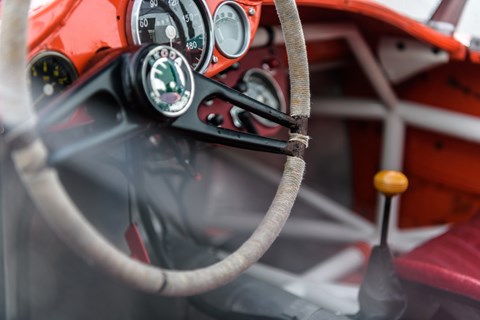
The rest reads like the set up to a captivating film script – with production cars deemed too valuable to race, and Skoda’s works team effectively reduced to a handful of enthusiasts working odd evenings and weekends, the bespoke 1100 OHC prototype was born, against the odds.
What’s it like to drive?
‘Pick up some speed on the back straight, move towards the middle of the track and give the drum brakes a big push so you can get a feel for them. It’ll seem like they’re not working at first and then they’ll bind up.’
Steve, the driver who looks after the car has just come in from a fiercely fast-looking couple of warm-up laps at Bicester Heritage Centre and offers me a few words of encouragement.
‘Try to double declutch your gearshifts too as it’s quite a crunchy box, and it’s slippery on the corners around the back too, so be careful.’
That last comment is an understatement – the track is soaking and the car is wearing cross-ply tyres so thin I’d think twice about fitting them to a wheelbarrow. The Red Racer is insured for £250,000 but considering its rarity, it’s hard to think of it as anything other than irreplaceable.
High-stakes then?
Regardless of value this really isn’t a car you’d want to get it wrong in – thanks to its thin-wall welded tubular chassis and glass fibre bodywork. Also there are no seatbelts, and there’s more of the driver outside the car than in.
Only two remain – one of which lives in the Skoda museum in Prague and this car, 395 UXU, which is owned by Skoda UK after being mothballed in the 1960s at end of its racing life.
It was purchased in 1968 for a handful of crowns by a London-based Czech student called Martin Svetnicka, who boldly planned to drive the car home in the middle of winter – despite the lack of heater, windscreen, or roof. He eventually left it in a German workshop after a breakdown, before sensibly returning with a trailer to tow it home.
His restoration was plagued by a lack of parts, so Svetnicka eventually sold the car to the Midland Motor Museum in 1972 where it remained for 15 years. It swapped hands a couple more times before in 1998 it was purchased by Skoda at auction for £46,600, where it immediately underwent a full restoration.
What’s it like to sit in?
I figured the cabin would be a bit of a tight fit, having been tailor-made for a whippet-thin 1950s racing driver who was a bit shorter than this six foot two inch oaf.
Don’t bother opening the low door to get in, just step over it (a movement that barely requires lifting my leg over hip height), stand on the seat and then slide your feet down under the dashboard, like getting into a kayak. Or putting on a big pair of red trousers.
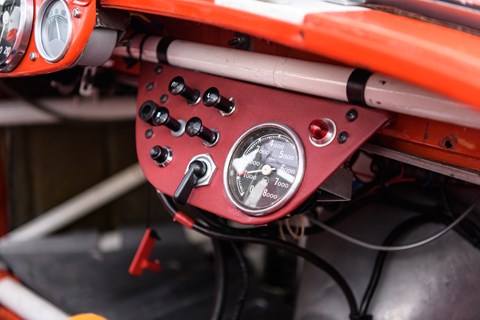
Steve recommends heel and toeing my downshifts to show a bit of mechanical sympathy to the aging components. The distance between the seat base on the pedals is so short that my legs are bent and my feet locked upright, like I’ve just trodden on Lego. I can push the pedals to the floor easily enough, but more finessed movements will basically have to come from my thighs.
‘Put it in reverse before you put it in first’ Steve helpfully calls over the din of the roughly idling engine as I struggle with the dogleg gearbox. I feel like I’m getting a glimpse of the deep end here.
What powers this mighty beast?
Under the bonnet is the same basic lump from Skoda’s small family car of the 1950s, the Tudor sedan. A longitudinally mounted, inline four-cylinder displacing 1,089cc.
In the racing car it gains a new cylinder head with two camshafts (hence OHC) plus hemispherical chambers, doubled-up spark plugs, coils and distributors, and a pair of twin-choke sidedraught carburettors. The restored car runs on normal petrol but the original regularly used aviation fuel to get maximum power. You know, like an aeroplane.
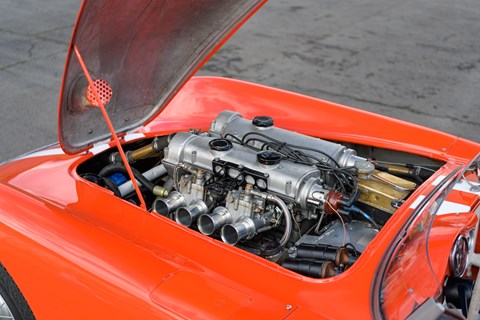
All this means an impressive specific output of 92bhp at 7,700rpm and a redline of 8,500rpm – power figures that Skoda can replicate 60 years later with a similarly sized engine, but only if it straps a turbo on.
That doesn’t sound a lot but this car is seriously light, so much so that it boasts the same power to weight ratio as a modern Octavia vRS 245.
Does it go like one?
Like most race cars the 1100 OHC is unhappy about sitting still – but once you’ve wrestled it into first gear and pulled away without stalling (phew) it loosens up, and feels positively raring to go.
On my sight-seeing first lap the intimidating nature of the car beings to fade and at a relaxed pace this historic racer is relatively modern in the way it drives. The controls are pretty heavy and require firm inputs – the gearshift especially, which feels very sweet in its action as long as you’re prepared to absolutely heft it between the gates – something that feels very wrong in a vehicle you’d need a mortgage to buy.
Like Steve warned the brakes are pretty inert until you lean on the heavily sprung pedal, at which point they wake up a bit. Modern cars offer a strong initial bite that needs easing off before the corner.
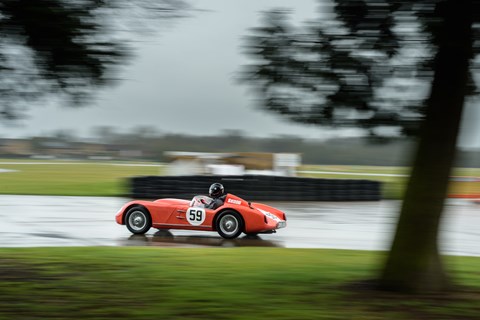
These are the other way around – you hammer the pedal before you need to slow down, and wait for the drums to eventually do their thing. Heel and toeing turns out to be quite easy because the pedals are super close and I’ve got size 12 feet. Sometimes I even manage to do it deliberately.
I’ve also got the benefit of a damp track that is gradually dehydrating itself in the sun, unlike the journalists before me who had to factor standing water into their test drives. The driver previous to me warned it was ‘sideways, everywhere’ but I’m finding it quite grippy in the dry. Before long my first stint is over and it’s back to the pits for a cool down and to attach some GoPros.
Won’t they ruin the weight distribution?
Adding anything to this car feels like sacrilege – with its engine up front and five speed manual gearbox, clutch and differential located behind the cabin the 1100 OHC boasts near 50/50 distribution.
The 75kg weight of the driver, Miroslav Fousek, was even taken into consideration when finalising the position of the engine – which means a big Christmas dinner (or a husky journalist) will effectively wreck the engineers’ work.
Many of the car’s surfaces have been drilled to save weight and the seats are thin and barely padded, plus there’s no roll cage or even seat belts, so it weighs just 550kg. The hardtop model featured aluminium rather than glass fibre bodywork, adding 68kg.
Does that lightness make it a bit of a handful?
Back on track and I’m revelling at the faithful front end – understeer really isn’t a feature. A too-bold entry speed or lift-off the gas mid-corner will result in a manageable shuffle from the rear axle, rather than a massive career-ending spin. Get it right and the Red Racer feels amazingly poised, your cornering angle easily influenced by the super-sharp throttle.
With a neatly balanced car and largely misplaced confidence I go for a stab of gas on the exit of the last corner before the straight and manage an untidy slide. I let the wheel spin through my hands because I’m lazy and the string wound around the rim sandpapers my palms. Then one of the spokes smashes into my thumb as I go to straighten up. I decide to hang onto it after that. A colleague later informs me this is Old Car 101.
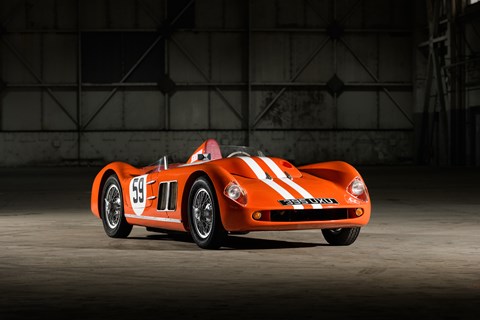
Accelerating onto the main straight and feeling like I’ve got a grasp of the braking distance at the end, I go for fourth gear – the tacho has stopped working so I judge the shift point from third by the noise – which is fantastic, by the way, raucous and raw with the whining gearbox laid over the top.
I don’t dare look at the speedo but reckon it’s a fair way short of the top speed before I’m braking. I can’t imagine how much runway it’d require to haul this car up from 124mph but I suspect you’d need a lot. And some neoprene pants. After not enough time I’m called in for good and it’s someone else’s turn.
The 1100 OHC is in equal measure exhilarating and terrifying – somewhere between a takes-no-prisoners superkart and a progressive-but-still-precarious Caterham. And that’s when you’ve got an easy, empty circuit to drive it on – if you fancy a laugh there’s a great picture of one of the spiders being doorhandled on cobbles with the rear-right tyre folded over on itself. Bold.
Was it a successful racecar?
The Skoda 1100 OHC made its first appearance in 1957 and its competition debut followed a year after, in a race around the municipal circuit in Mlada Boleslav where Miroslav Fousek took the victory.
Success followed in Lidici and then Louny, and it also competed in factory-approved races abroad, including the Leningrad Grand Prix of 1959, where the Skoda finished first ahead of more powerful Russian competition.

Victories continued throughout eastern Europe until around 1962 – when the standardised international formulae were introduced – and Skoda shifted its focus from prototypes to single-seater Formula 3 cars and rallying.
Skoda 1100 OHC ‘Red Racer’: verdict
For years now Skoda has traded under the tagline ‘Simply Clever’. No-nonsense, uncomplicated cars that do everything you need and quite often have an ice scraper hidden under the petrol flap.
Study the Czech maker’s product road-map for the next two to three years though and while Skoda’s cars appear to be maxing out on the clever part, they sure don’t look simple – greater electrification, more SUVs and the introduction of autonomous driving.
What a good opportunity then to rewind to a time when Skoda’s racing division offered the ultimate in clever simplicity – a car weighing barely half a tonne that offered terrifying speeds to brave enough drivers. Happy birthday, 1100 OHC.
Read our Skoda reviews